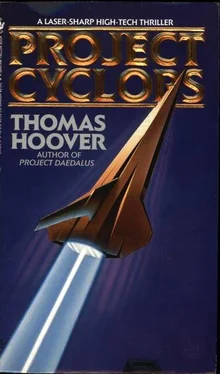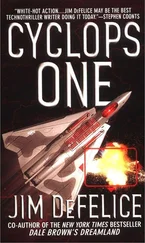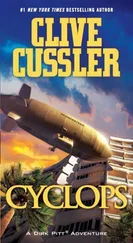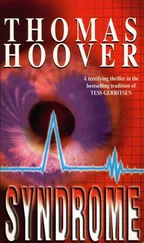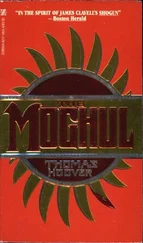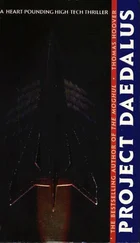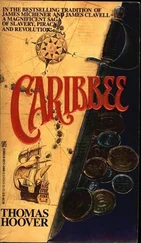Thomas Hoover - Project Cyclops
Здесь есть возможность читать онлайн «Thomas Hoover - Project Cyclops» весь текст электронной книги совершенно бесплатно (целиком полную версию без сокращений). В некоторых случаях можно слушать аудио, скачать через торрент в формате fb2 и присутствует краткое содержание. Жанр: Триллер, на английском языке. Описание произведения, (предисловие) а так же отзывы посетителей доступны на портале библиотеки ЛибКат.
- Название:Project Cyclops
- Автор:
- Жанр:
- Год:неизвестен
- ISBN:нет данных
- Рейтинг книги:4 / 5. Голосов: 1
-
Избранное:Добавить в избранное
- Отзывы:
-
Ваша оценка:
- 80
- 1
- 2
- 3
- 4
- 5
Project Cyclops: краткое содержание, описание и аннотация
Предлагаем к чтению аннотацию, описание, краткое содержание или предисловие (зависит от того, что написал сам автор книги «Project Cyclops»). Если вы не нашли необходимую информацию о книге — напишите в комментариях, мы постараемся отыскать её.
Project Cyclops — читать онлайн бесплатно полную книгу (весь текст) целиком
Ниже представлен текст книги, разбитый по страницам. Система сохранения места последней прочитанной страницы, позволяет с удобством читать онлайн бесплатно книгу «Project Cyclops», без необходимости каждый раз заново искать на чём Вы остановились. Поставьте закладку, и сможете в любой момент перейти на страницу, на которой закончили чтение.
Интервал:
Закладка:
Now the roar of water began to overwhelm the hum of the pumps. The conduit was filling rapidly, and flow had begun. He realized that only about a foot of airspace remained at the top. Praying for a miracle, he heaved against the metal wheel one last time, and finally felt it break loose, begin to turn.
2:38 P.M.
"Abdoullah" had finished unpacking the second crate, and now he examined what he had: two fifteen-kiloton nuclear devices, made using enriched uranium-235 from the Kahuta Nuclear Research Center. He smiled again to think they had been smuggled out right from under the noses of the officials at Kahuta, directly up the security elevators leading down to the U235 centrifuge at Level Five.
The research center was situated more or less in between the sister cities of Rawalpindi and Islamabad, in northeast Pakistan, where it was surrounded by barren, scrub-brush rolling hills that looked toward the looming border of Afghanistan. Kahuta was the heart of Pakistan's nuclear-weapons program, and its many levels of high-security infrastructure were buried deep belowground. The only structure visible to a satellite was the telltale concrete cupola and an adjacent environmental-control plant for air filtration. Security was tight, with high fences, watchtowers, and an army barracks near at hand.
The security was for a reason. In 1975 Pakistan began acquiring hardware and technology for a plant capable of producing weapons-grade uranium. Bombs require 90 percent enrichment, and when the U.S. discovered the project, it had threatened to cut off aid if any uranium was enriched beyond 5 percent. Pakistan agreed, then went right ahead. Between 1977 and 1980, using dummy corporations and transshipments through third countries, the government smuggled from West Germany an entire plant for converting uranium powder into uranium hexafluoride, a compound easily gasified and then enriched. Two years later the Nuclear Research Center purchased a ton of specially hardened "maraging" steel, from West Germany, which was delivered already fabricated into round bars whose diameter exactly matched that of the (also) German gas centrifuges under construction at Kahuta. Shortly thereafter, the plant at Dera Ghazi Khan was on-line, producing uranium hexafluoride feedstock for the Kahuta enrichment facility, and the Kahuta facility was using it to turn out U235 enriched uranium in abundance.
At the same time, Pakistani operatives were hastening to acquire high-speed American electronic switches called krytrons, the triggering devices for a bomb. Their efforts to obtain nuclear detonators required several tries, but eventually they got what they needed. They dispensed with above-ground testing of the nuclear devices they had assembled, having procured the necessary data from China, and instead just went ahead and made their bombs. They then secured them on Level Five of the Kahuta reprocessing facility-against the day they would be needed.
Until now. Liberating two of those well-guarded A-bombs had required a lot of unofficial cooperation from the plant's security forces. Batteries of surface-to-air missiles protected Kahuta from air penetration, and elite paratroopers and army tanks reinforced the many checkpoints, making sure that no vehicle, official or private, could enter or leave the complex without a stamped authorization by the security chief. Only a lot of money in the right hands could make two of the devices disappear. Sabri Ramirez had seen to that small technicality…
Abdoullah patted one of the nuclear weapons casually and admired it. The bomb itself was a half meter in diameter, its outer casing of Octol carefully packed inside a polished steel sheath embedded with wires. Expensive but available commercially, Octol was a 70-30 mixture of cyclote-tramethvlenetetranitramine and trinitrotoluene, known colloquially as HMX and TNT. It was stable, powerful, and the triggering agent of choice for nuclear devices. Inside the Octol encasing each device were twenty-five kilograms of 93 percent enriched U235. When the external Octol sphere was evenly detonated, it would compress the uranium core sufficiently to create a "critical mass,-' causing the naturally occurring radioactive decay of the uranium to focus in upon itself. Once the radiation intensified, it started an avalanche, an instantaneous chain reaction of atom-splitting that converted the uranium's mass into enormous quantities of energy.
The trick to making it work was an even, synchronous implosion of the outer sphere, which was the job of the high-tech krytron detonator switches…
Which, Abdoullah realized, were still in the Sikorsky. The krytrons were packed separately and handled as though they were finest crystal.
"Rais," he said, looking up and addressing his Berkeley classmate now standing by the door, "I need the detonators."
"Well, they're in the cockpit, where we stowed them." He was tightening his commando sweatband, itching to try out his Uzi, still unfamiliar. Would the others notice? In any case, he wasn't here to run errands.
"Then go get them, for chrissake." He had considered Rais to be an asshole from the day they first met in the Advanced Quantum Mechanics class at college. Nothing that had happened since had in any way undermined that conviction. The guy thought he was hot stuff, God's gift to the world. It was not a view that anybody who knew him shared.
"Why don't you go get them?" Rais said, not moving.
"Because I want to check these babies over and make sure everything is a go." What a jerk. "Come on, man, don't start giving me a lot of shit, okay? This is serious. Everybody's got to pull his weight around here."
Rais hesitated, his manhood on the line, and then decided to capitulate. At least for now. Abdoullah was starting to throw his weight around, get on the nerves. The guy was real close to stepping out of line.
"All right, fuck it." He clicked the safety on his Uzi on and off and on, then holstered it.
"As long as you're at it, why don't you just take them directly down to the clean room. We'll be assembling everything there anyway, since that's where the elevator is they use to go up and prep the vehicles."
"That's cool. See you down there." Rais closed the door and walked out into the Greek sunshine. He was starting to like this fucking place.
2:39 P.M.
Vance shoved the metal door open just as the roar of the onrushing water reached the confluence at the intersection of the tunnel, a mere hundred yards ahead. The tunnel was almost full now, the water flow increasing.
They're about to turn on the Cyclops, he thought. You've got about fifteen seconds left.
He pulled himself through the metal door, soaked but alive, and rolled onto a cement floor. With his last remaining strength he reached over and tipped the metal door shut, then grabbed the wheel and gave it a twist. Down below he could feel the wall of water surge by.
He thought he was going to faint, but instead he took a deep breath and pulled out the flashlight…
… And found himself in a communications conduit, consisting of a concrete floor with Styrofoam insulation overhead. All around him stretched what seemed miles of coaxial cables, wrapped in huge circular strands. The conduit also contained fiber-optics bundles for carrying computer data to guide the parabolic antennas up on the mountain as they tracked the space vehicle.
The major contents of the conduit, however, were massive copper power-transmission cables. What had Mannheim warned? How many gigawatts per second? The numbers were too mind-boggling to comprehend, or bother remembering. All they meant was that if the Cyclops were suddenly turned on, the Gaussian fields of electromagnetic flux would probably rearrange his brain cells permanently.
He rose and moved down the conduit, feeling along its curved sides, his back braced against the large bundle of power wires in the center while ahead of him the darkness gaped. A few yards farther, though, and the probing beam of his flashlight revealed a terminus where some of the shielded fiber optics had been shunted off into the wall, passing through a heavy metal sleeve.
Читать дальшеИнтервал:
Закладка:
Похожие книги на «Project Cyclops»
Представляем Вашему вниманию похожие книги на «Project Cyclops» списком для выбора. Мы отобрали схожую по названию и смыслу литературу в надежде предоставить читателям больше вариантов отыскать новые, интересные, ещё непрочитанные произведения.
Обсуждение, отзывы о книге «Project Cyclops» и просто собственные мнения читателей. Оставьте ваши комментарии, напишите, что Вы думаете о произведении, его смысле или главных героях. Укажите что конкретно понравилось, а что нет, и почему Вы так считаете.
